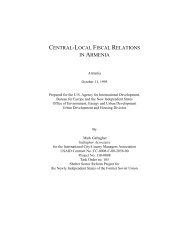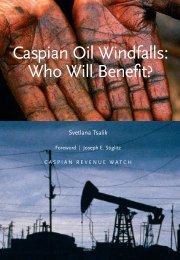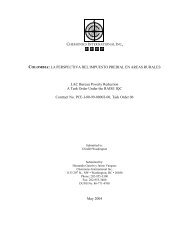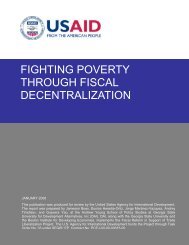Effectiveness and Economic Impact of Tax Incentives in the SADC ...
Effectiveness and Economic Impact of Tax Incentives in the SADC ...
Effectiveness and Economic Impact of Tax Incentives in the SADC ...
You also want an ePaper? Increase the reach of your titles
YUMPU automatically turns print PDFs into web optimized ePapers that Google loves.
3-14 EFFECTIVENESS AND IMPACT OF TAX INCENTIVES IN THE <strong>SADC</strong> REGION<br />
•<br />
to extrapolate from East Asian cases to recommend selective <strong>in</strong>terventions as a tool for<br />
<strong>in</strong>dustrial policy <strong>in</strong> countries with weaker public adm<strong>in</strong>istration <strong>and</strong> highly politicized<br />
procedures for decid<strong>in</strong>g who qualifies for benefits. The ma<strong>in</strong> conclusion from decades <strong>of</strong><br />
experience is that develop<strong>in</strong>g countries have largely failed <strong>in</strong> repeated efforts to nurture<br />
<strong>in</strong>fant <strong>in</strong>dustries by subsidiz<strong>in</strong>g <strong>and</strong> protect<strong>in</strong>g <strong>in</strong>efficient operations.<br />
The statement that <strong>in</strong>centives foster low-productivity <strong>in</strong>vestment is mitigated by <strong>the</strong><br />
importance <strong>of</strong> “footloose” projects that can just as well locate elsewhere. Such projects<br />
may be highly efficient, <strong>and</strong> <strong>the</strong>y can make a large contribution to knowledge transfer, job<br />
creation, <strong>and</strong> development. This argument applies ma<strong>in</strong>ly to footloose export-oriented<br />
projects. 34<br />
Ano<strong>the</strong>r consideration is that tax preferences may lead to social benefits that<br />
counterbalance <strong>the</strong> economic efficiency costs. For example, Zambia has a 15 percent<br />
<strong>in</strong>come tax rate for farm operations <strong>and</strong> a 35 percent rate for most o<strong>the</strong>r companies. This<br />
tax structure may draw resources <strong>in</strong>to agricultural <strong>in</strong>vestments that have a low rate <strong>of</strong><br />
return. Yet <strong>the</strong> policy reflects a political consensus to support farm enterprises,<br />
irrespective <strong>of</strong> productivity considerations. The important th<strong>in</strong>g is that such political<br />
decisions should be based on a clear underst<strong>and</strong><strong>in</strong>g <strong>of</strong> <strong>the</strong> economic consequences.<br />
Distorted Technical Decisions. In addition to favor<strong>in</strong>g certa<strong>in</strong> sectors, tax <strong>in</strong>centives also<br />
distort technical decisions. Poorly designed programs have un<strong>in</strong>tended consequences that<br />
may operate at cross purposes with o<strong>the</strong>r objectives <strong>of</strong> government policy. For example,<br />
⎯ <strong>Tax</strong> preferences that reduce <strong>the</strong> cost <strong>of</strong> capital systematically favor capital-<strong>in</strong>tensive<br />
over labor-<strong>in</strong>tensive <strong>in</strong>vestments, which reduces <strong>the</strong> impact <strong>of</strong> <strong>in</strong>vestment on job<br />
creation.<br />
⎯ <strong>Tax</strong> holidays will favor short-term over long-term <strong>in</strong>vestments. 35<br />
⎯ Exemptions from import duty on capital goods will favor production activities that<br />
depend on imported capital, reduc<strong>in</strong>g <strong>the</strong> <strong>in</strong>centive to develop local capital goods<br />
<strong>in</strong>dustries.<br />
⎯ Exemptions from duty on imported raw materials <strong>and</strong> <strong>in</strong>termediate goods favor<br />
activities that use imported <strong>in</strong>puts, impair<strong>in</strong>g <strong>the</strong> development <strong>of</strong> backward<br />
l<strong>in</strong>kages. 36<br />
to experiment <strong>and</strong> <strong>in</strong>novate is suppressed. What appears to be a low-return activity for <strong>the</strong> entrepreneur can<br />
have a high rate <strong>of</strong> return for <strong>the</strong> economy overall.<br />
34 To be sure, not all export projects are equal. Some enclave export activities generate few benefits for <strong>the</strong> host<br />
economy, even though <strong>the</strong>y may be efficient <strong>in</strong> <strong>the</strong>ir production technology.<br />
35 UNCTAD (2002), p. 219 cites studies show<strong>in</strong>g that <strong>in</strong>vestment tax <strong>in</strong>centives <strong>in</strong> Brazil, Indonesia, Malaysia,<br />
Mexico, Pakistan, Thail<strong>and</strong>, <strong>and</strong> Turkey “led to distorted <strong>in</strong>vestment decisions, partly because <strong>the</strong>y<br />
discrim<strong>in</strong>ated between firms that showed losses <strong>in</strong> early years <strong>and</strong> those that did not, <strong>and</strong> between relatively<br />
capital-<strong>in</strong>tensive <strong>and</strong> relatively labour-<strong>in</strong>tensive activities.”<br />
36 Moran (2001) f<strong>in</strong>ds that l<strong>in</strong>kage requirements tend to backfire by mak<strong>in</strong>g down-stream activities less<br />
pr<strong>of</strong>itable, which reduces <strong>in</strong>vestment <strong>and</strong> slows growth. He concludes that l<strong>in</strong>kage effects develop more<br />
strongly when producers are given <strong>the</strong> freedom to pursue market <strong>in</strong>centives.











